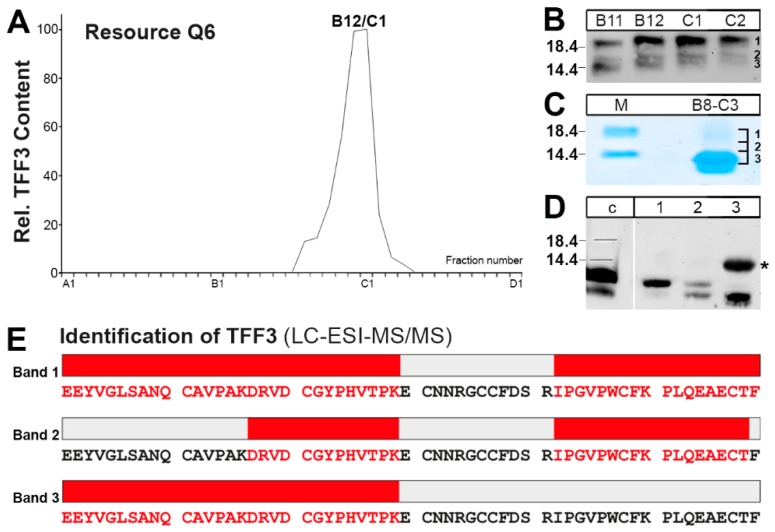Figure 3.
Purification of different forms of TFF3 from saliva and characterization by LC-ESI-MS/MS analysis. (A) Saliva of a single individual (S-20) was purified via SEC on a Superdex 75HL column (analogous to Figure 1) and then the low-molecular-mass region (about fractions C8-D5) subsequently separated by anion exchange chromatography on a Resource Q6 column. Shown is the distribution of the relative TFF3 immunoreactivity in the fractions as determined by Western blot analysis under reducing conditions and semi-quantitative analysis of the typical 7k-band intensities (monomeric TFF3). Fractions B8-C3 were concentrated, desalted and further analyzed. (B) 15% SDS-PAGE under non-reducing conditions of fractions B11–C2 (see (A)) and subsequent Western blot analysis concerning TFF3 (marked are bands 1-3). (C) Separation of combined fractions B8-C3 (see (A)) by non-reducing 15% SDS-PAGE followed by Coomassie staining. Marked are the bands excised (1, 2, 3) and subjected to Western blot analysis under reducing conditions or LC-ESI-MS/MS analysis. (D) Separation of the excised bands 1, 2, and 3 (see (C)) by 15% SDS-PAGE under reducing conditions and Western blot analysis concerning TFF3. For comparison, a human colon extract is shown (lane c). The star marks a non-specific band in lane 3 recognized by the anti-TFF3 antiserum. (E) Results of the LC-ESI-MS/MS analysis after tryptic in-gel digestion of the bands 1, 2, and 3, respectively. Identified tryptic peptides belonging to TFF3 are highlighted in red.

